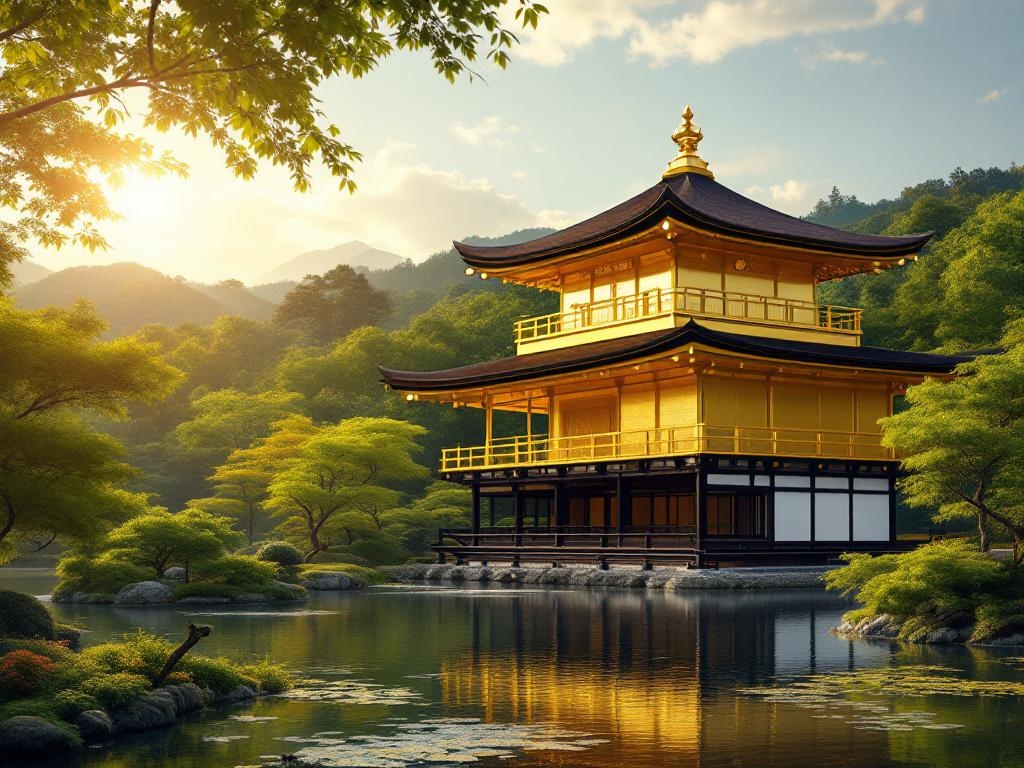Exploring Kyoto’s Kinkaku-ji (Golden Pavilion)
Discover Kyoto’s breathtaking Kinkaku-ji, a UNESCO World Heritage Site. Marvel at the Golden Pavilion’s shimmering gold leaf exterior and serene gardens. Explore its rich history as a shogun’s villa turned Zen Buddhist temple. Plan your visit now and experience the tranquility of this iconic landmark.
Important information

- Kinkaku-ji, known as the Golden Pavilion, is a Zen Buddhist temple in Kyoto and a UNESCO World Heritage Site.
- Originally built in the 14th century, it served as a shogun’s villa before becoming a temple.
- The pavilion’s exterior is covered in gold leaf, reflecting in the Kyoko-chi (Mirror Pond).
- The temple grounds feature serene gardens, perfect for contemplation and reflection.
- Visitors can reach Kinkaku-ji by bus from Kyoto Station (routes 101 or 205).
Discovering Kyoto’s Kinkaku-ji: The Golden Pavilion
Kyoto’s Golden Pavilion, Kinkaku-ji, is a stunning Zen Buddhist temple, its gold leaf exterior shimmering amidst tranquil gardens. This serene beauty and undeniable cultural significance have earned it UNESCO World Heritage status. The temple exemplifies Muromachi period architecture and garden design, seamlessly blending nature and human artistry. Before you travel, make sure you have the necessary visa or permits. Use our travel entry requirements checker available on Passport Free Countries.
What Makes Kinkaku-ji a UNESCO World Heritage Site?
Kinkaku-ji, a UNESCO World Heritage site, exemplifies Japanese aesthetics with its distinctive design and rich history. Originally a shogun’s villa, the temple’s conversion into a Zen Buddhist sanctuary adds to its profound significance. Set amidst tranquil gardens and a breathtaking landscape, its cultural richness is undeniable. The pavilion’s brilliant gold leaf and unique architectural style further enhance its appeal, making Kinkaku-ji a true Japanese treasure.
The Golden Pavilion’s Historical Significance
Kinkaku-ji, originally built in the 14th century as Shogun Ashikaga Yoshimitsu’s retirement villa, was later transformed into a Zen Buddhist temple after his death. This stunning structure seamlessly blends nature and architecture, showcasing Japan’s rich cultural heritage and architectural ingenuity. Reconstructed in 1955, Kinkaku-ji stands as a potent symbol of Zen Buddhist values and a testament to both history and enduring beauty.
Architectural Marvel: The Golden Façade and Gold Leaf Exterior
Kinkaku-ji, covered in dazzling gold leaf, is a radiant example of Muromachi period architecture. Its simple design harmonizes with the surrounding natural beauty. The gold symbolizes both wealth and purity, key tenets of Zen Buddhism. Inside, traditional elements like tatami mats and sliding doors evoke classic Japanese aesthetics, creating a tranquil atmosphere.
The Serene Ambiance of Kinkaku-ji’s Temple Grounds
Kinkaku-ji’s gardens offer a serene escape, inviting visitors to stroll along paths and admire the meticulous landscaping. Stone lanterns, bridges, and carefully placed trees enhance the beauty, framing stunning views of the Golden Pavilion from various angles. Kyoko-chi, the Mirror Pond, reflects the Golden Pavilion, creating a picturesque scene. Its stillness enhances the serenity, inviting contemplation and contributing to the overall harmony of the temple grounds. Kinkaku-ji promotes mindfulness and reflection, offering a space for contemplation in line with Zen Buddhist principles. The tranquil setting encourages a connection with nature, helping visitors find inner peace. The teahouse at Kinkaku-ji provides a cultural experience where visitors can enjoy matcha tea and Japanese sweets. This tranquil spot offers yet another vantage point to appreciate the gardens, further enhancing the serene ambiance.
Exploring the Temple Gardens and Ornamental Surroundings
Kinkaku-ji’s gardens offer a serene escape. Their meticulously maintained paths, rocks, and trees create a truly peaceful atmosphere. The temple’s beauty is further enhanced by diverse plants and wildlife. These tranquil surroundings are perfect for contemplation and photography, allowing visitors to admire the scenery and reflect.
Kyoko-chi (Mirror Pond): A Reflection of Tranquility
Kyoko-chi (Mirror Pond) is integral to Kinkaku-ji’s design, perfectly reflecting the temple and its surrounding gardens to create a stunning visual effect. On clear days, these reflections enhance the tranquil atmosphere. The pond is key to the temple grounds, contributing significantly to its serene ambiance and undeniable beauty.
Experiencing Zen Buddhism and Mindfulness
Kinkaku-ji offers a tranquil setting perfect for reflection and contemplation. The temple grounds encourage mindful exploration, inviting visitors to wander and ponder. Guests can participate in traditional practices such as meditation and incense burning to gain insight into Zen Buddhism and its emphasis on presence and inner peace. This fosters a profound sense of calm.
The Teahouse: A Cultural Experience
Experience the rich customs and rituals of Japanese tea culture with a traditional ceremony at Kinkaku-ji’s teahouse.
Planning Your Visit to Kinkaku-ji
Kinkaku-ji is open daily from 9:00 am to 5:00 pm. Admission is 400 yen for adults and 300 yen for children.
Getting There
Getting to Kinkaku-ji by public transport is easy. Take bus 101 or 205 from Kyoto Station. Many other buses connect the temple to central Kyoto locations. Follow the clear signage from the bus stop.
Tips for Your Visit
- Arrive early in the morning or late in the afternoon for better lighting and fewer crowds.
- Wear comfortable shoes.
- Check the weather forecast.
- Consider a guided tour for a deeper understanding of the temple’s history and significance.
Don’t forget to take photos of the Golden Pavilion and its reflection in Kyoko-chi pond. Experiment with different angles and lighting. Early morning or late afternoon light offers the best photographic conditions.
Visiting Hours and Entrance Fees
Kinkaku-ji is open daily from 9:00 AM to 5:00 PM. The entrance fee is ¥400 for adults and ¥300 for children. These fees help maintain the temple.
How to Reach Kinkaku-ji Using Public Transport
Getting to your destination is easy. From Kyoto Station, take bus 101 or 205. If you’re leaving from Kitaoji Station, take bus 204 or 205. You can also take bus 59 from Emmachi Station.
Travel Tips and Best Times to Visit
Experience the beauty of Japan’s cherry blossoms in spring or the vibrant autumn foliage. To avoid crowds, arrive early or late in the afternoon. Capture stunning photos while respecting site regulations. Wear comfortable shoes for exploring temple grounds and gardens. Enhance your visit with a nearby Zen garden and traditional tea house experience.
Guided Tours: Enhancing Your Visit
Enhance your visit to Kinkaku-ji with a guided tour that unveils the Golden Pavilion’s captivating history, unique architecture, and Zen Buddhist influences. Expert guides provide valuable context, deepening your understanding and appreciation of this UNESCO World Heritage Site. They reveal intricate details often overlooked by independent explorers, offering insightful perspectives for a richer, more complete experience. A guided tour ensures you won’t miss essential aspects of Kinkaku-ji, such as:
- the history of the Ashikaga shogunate and its connection to the Golden Pavilion,
- the architectural significance of the three distinct styles incorporated into each floor,
- the symbolism of the golden leaf and its reflection in Kyoko-chi pond,
- the role of Kinkaku-ji as a Rinzai Zen Buddhist temple,
- the serene gardens surrounding the pavilion and their connection to Zen philosophy.
Photography Tips for Capturing the Golden Pavilion
Capture breathtaking photos of Kinkaku-ji’s golden reflection shimmering in Kyoko-chi (Mirror Pond), creating a truly iconic image. The soft light of early morning or late afternoon illuminates the gold leaf, making it absolutely radiant. Wander through the surrounding gardens and explore the pond from various vantage points to discover your own unique, perfect shot.













